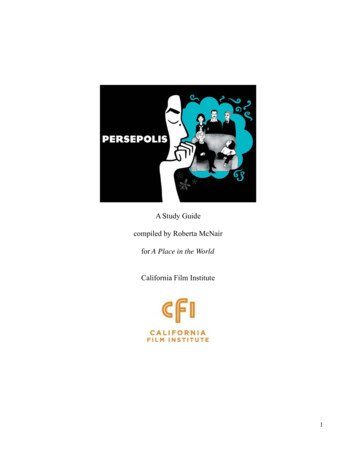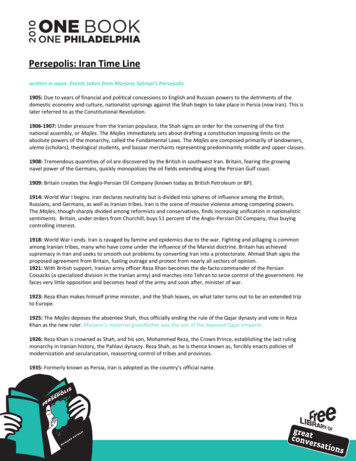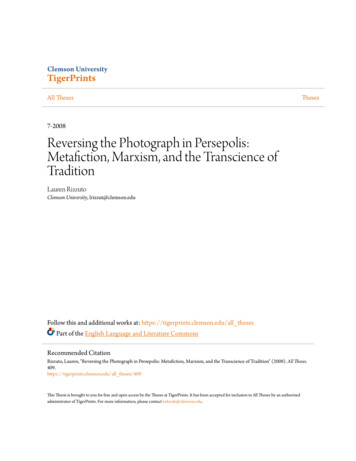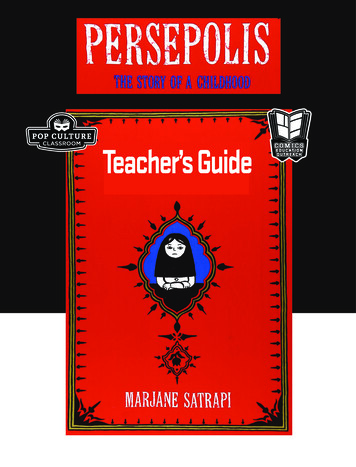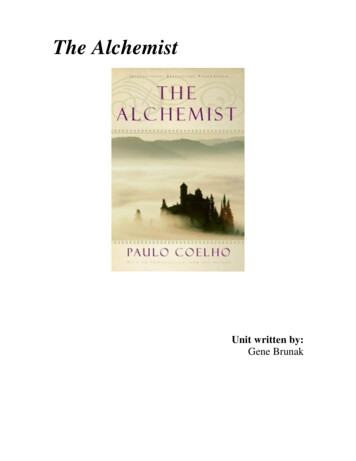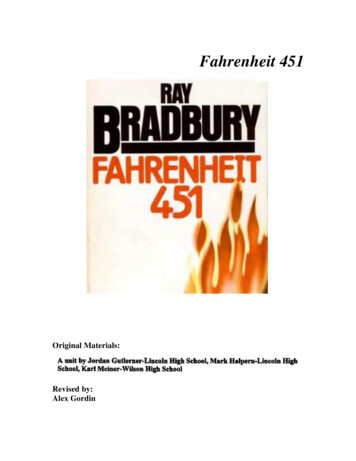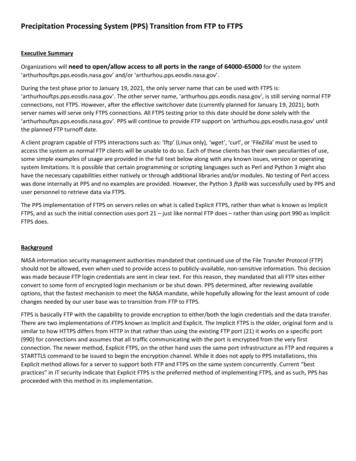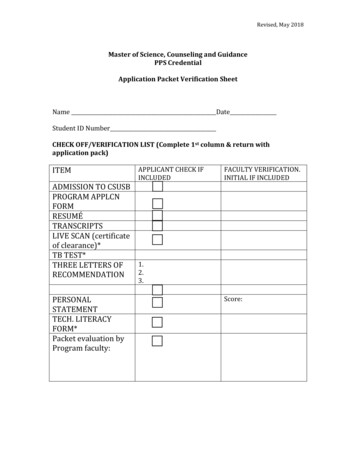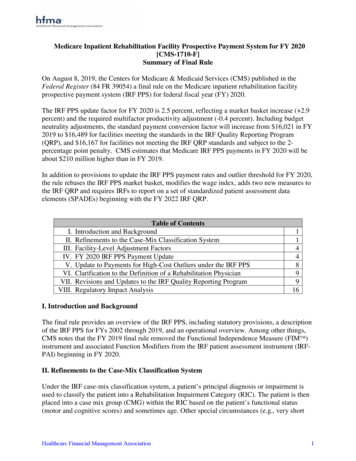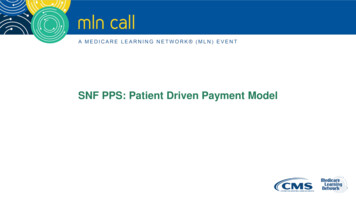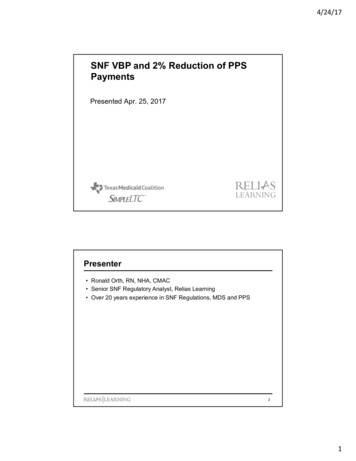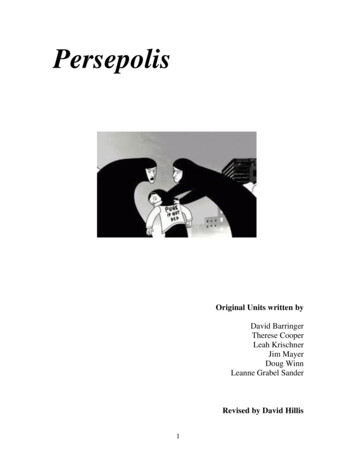
Transcription
PersepolisOriginal Units written byDavid BarringerTherese CooperLeah KrischnerJim MayerDoug WinnLeanne Grabel SanderRevised by David Hillis1
Introduction to the Revised UnitThis articulation of the PPS Persepolis curriculum guide focuses on understandingbeliefs, both our own personal beliefs and the belief systems within cultures. Studentswill write a personal narrative about a time when a belief was challenged and changed,while participating in a unit that aims to be just such an experience. The activities andthe resources of this unit promote a deeper understanding of Iran and its peoples.Students will also be asked to think critically about their own culture and representationsof Iran in popular media.PPS teachers have developed many different ways to teach Persepolis, and I’ve includedthe introductions to both the PPS Persepolis Curriculum Guide and the PPS PersepolisAddendum because many of the essential questions remain the same, but I have alsoincluded them so that new teachers approaching the text through this guide will befamiliar with other directions for Persepolis in the classroom. My feeling is that this is aproblematic text simply because there are so many priceless teaching opportunities. Inthe English departments at many of our schools, it is likely the only classroom experiencewith the graphic novel, Iranian culture, CIA covert operations and torture, and, in thecontext of our (2010) year long sophomore curriculum, the only unit focusing onnarrative craft. This isn't a comprehensive list. There is simply too much to teach, andgiven some preconceptions about the literary merit of a graphic novel, allowing the unitto sprawl into a quarter long exploration of history, politics, and culture may not be wise.I've tried to address as many of these issues as possible while providing students withmultiple opportunities to practice and demonstrate mastery of the priority standardschosen for the unit template. Anyone consulting this unit plan should be allowed thefreedom to do the same, discarding and adding activities to meet the needs of a particularstudent population.If you are teaching this text for the first time, you should review the supporting materialsin the original curriculum guide before you begin. There you will find chaptersummaries that include warnings about potentially objectionable material as well ashelpful tips about challenging concepts and vocabulary.By David Hillis2
Introduction to Original Curriculum Guide3
Introduction to Addendum4
PERSEPOLIS Unit TemplateStage 1 – Desired ResultsPriority Standards (4-5 only): Number and brief summaryReading10.07 – Draw conclusions about reasons for actions/beliefs and support assertions.Literature10.11 – Describe the function and effect upon a literary work of common literary devices.Writing10.16.4 – Variation in sentence structure, length, and beginnings adds interest to the text.10.18.11 – Reveal the significance of the subject and events.10.18.12 -- Develop a common place specific occasion as the basis for the reflection.Speaking10.23 – Compare and Contrast ideas and points of view in media.UnderstandingsStudents will understand that. Iran is not part of an “Evil Empire,” butrather an ancient and complex society. There are nuances to literary featuresand devices in Graphic Novels thatmake them worthy of study. This graphic novel provides anopportunity to imagine other ways ofseeing and living. In this sense, it isgreat literature with the power toinfluence politics and real human eventsas it prompts the individual to reevaluate their worldview.Essential Questions What are the benefits and boundaries of aculture? How is our understanding of society andculture constructed? How are stereotypes constructed anddeconstructed? How are children and young adults affectedby a cultural revolution? How do cultures radicalize people? Are graphic novels literature worthy ofstudy in the classroom?Students will know .(facts and knowledge) Geographical, political, historical aswell as social aspects of Iranian life andIran's relationship with America. Human rights abuses perpetrated by theCIA, Shah, and members of the IslamicRevolution. Literary features and devices present inthe novel.Students will be able to .(apply skills) Break down stereotypes to gain a betterunderstanding of Iranian culture. Compare and contrast media for bias,beliefs, reasoning. Use a writing process to compose anarrative. Write a narrative and reflect on itssignificance. Vary sentence structure Identify literary features and devices,describe their use, and apply them to theirown work. Respond to injustice with action.5
Stage 2 – Assessment EvidenceCulminating Assessment (authentic):Other Evidence (variety of forms and modes)Narrative/Reflective Essay: Write a 500-wordreflective essay that examines a period of time1. Expeditionary Learning Activityin your life when one of your beliefs was2. Tea Partychallenged by an event, a person, a piece of3. Quick writesreading, an accident, and underwent a change.4. DiscussionsClearly state your original belief. Explain what5. Graphic Storytellingevents, people, books, lightning strikes, etc.,6. Exit Slipchallenged your belief and led to the change.7. Concept SortingThen, clearly state your new belief. Be specific8. Human Rights Actionwith your details, keep your sentences varied,yet tight, and remember to use active verbs.6
Stage 3: Learning Plan – PersepolisActivity TitlePriority StandardsLesson #1:Essential QuestionEssential Question10.18.11 – Reveal the significance of thesubject and events.Lesson #2:Pre-Assessment:Eye-OpeningExperiences10.07 – Draw conclusions about reasonsfor actions/beliefs and support assertions.10.11 – Describe the function and effectupon a literary work of common literarydevices.10.16.4 – Variation in sentence structure,length, and beginnings adds interest to thetext.10.18.11 – Reveal the significance of thesubject and events.10.18.12 -- Develop a common placespecific occasion as the basis for thereflection.14Lesson #3:ExpeditionaryLearning10.07 – Draw conclusions about reasonsfor actions/beliefs and support assertions.10.23 – Compare and Contrast ideas andpoints of view in media.1724-42Lesson #4:Quickwrite PromptPool10.07 – Draw conclusions about reasonsfor actions/beliefs and support assertions.10.18.11 – Reveal the significance of thesubject and events.10.18.12 -- Develop a common placespecific occasion as the basis for thereflection.1945-4616a (addendum)Lesson #5:Study/DiscussionQuestions10.7; 10.11;2047 and 48Lesson #6: Create aGraphic Story10.07 – Draw conclusions about reasonsfor actions/beliefs and support assertions.10.11 – Describe the function and effectupon a literary work of common literary10.07 – Draw conclusions about reasonsfor actions/beliefs and support assertions.10.11 – Describe the function and effect7ThisGuide1221OriginalGuides
Activity TitlePriority StandardsThisGuideOriginalGuidesupon a literary work of common literarydevices.10.16.4 – Variation in sentence structure,length, and beginnings adds interest to thetext.10.18.11 – Reveal the significance of thesubject and events.10.18.12 -- Develop a common placespecific occasion as the basis for thereflection.10.07 – Draw conclusions about reasonsfor actions/beliefs and support assertions.10.11 – Describe the function and effectupon a literary work of common literarydevices.10.16.4 – Variation in sentence structure,length, and beginnings adds interest to thetext.10.18.11 – Reveal the significance of thesubject and events.10.18.12 -- Develop a common placespecific occasion as the basis for thereflection.10.07 – Draw conclusions about reasonsfor actions/beliefs and support assertions.10.23 – Compare and Contrast ideas andpoints of view in media.3010.07 – Draw conclusions about reasonsfor actions/beliefs and support assertions.10.23 – Compare and Contrast ideas andpoints of view in media.4366-8010.07 – Draw conclusions about reasonsLesson #10:Focusing Your Lens for actions/beliefs and support assertions.10.11 – Describe the function and effectto Find the Jewelupon a literary work of common literarydevices.10.18.11 – Reveal the significance of thesubject and events.10.18.12 -- Develop a common placespecific occasion as the basis for thereflection.446a, 7a, 8aLesson #7: Revisingthe Graphic StoryLesson #8: IranianHistorical TreasureHuntLesson #9: HumanRights Action839(addendum)
Activity TitlePriority StandardsLesson #11:Subjective AndObjective Realities10.07 – Draw conclusions about reasonsfor actions/beliefs and support assertions.10.11 – Describe the function and effectupon a literary work of common literarydevices.10.18.11 – Reveal the significance of thesubject and events.10.18.12 -- Develop a common placespecific occasion as the basis for thereflection.CulminatingAssessment:Narrative10.07 – Draw conclusions about reasonsfor actions/beliefs and support assertions.10.11 – Describe the function and effectupon a literary work of common literarydevices.10.16.4 – Variation in sentence structure,length, and beginnings adds interest to thetext.10.18.11 – Reveal the significance of thesubject and events.10.18.12 -- Develop a common placespecific occasion as the basis for thereflection.46Lesson #13:A Worthy Unit(Reflection)10.11 – Describe the function and effectupon a literary work of common literarydevices.10.23 – Compare and Contrast ideas andpoints of view in media.50ResourcesThisGuide45529OriginalGuides9a
Academic VocabularyThe vocabulary used extensively in this unit on Persepolis:ObjectiveActive VerbsMetaphoric LanguageLiterary FeaturesLiterary ySettingSensory DetailsSubjectiveThe following terms and background knowledge will be essential for your students igrationExile10
Possible Schedule for UnitMondayTuesdayWednesdayThursdayFridayEssential QuestionCarouselPre-assessment“The HWK: Write thenarrativeFilm – GlobeTrekker or RickSteves' IranHWK: CurrentEvents article(optional)Discussionbased onPrompt Pooland based onPrompt Pooland based onPrompt Pooland StudyQuestionsandsupplementaryactivitiesHWK-- read andrespond toCh, 5--9HWK – Read andRespond toCh. 10-14Discussionbased onPrompt Pooland StudyQuestionsRevising theGraphic StoryShare GraphicStoryHWK – GraphicStory Draft DueHWK – Finish theGraphic StoryHuman RightsAction Day 2Introduce NarrativeTeacher gPick up booksDistribute PoliticalTermsRead and discussopening, questions,predictionsHWK: Read andrespond to 1-4;study questions andprompt poolShare NarrativesGraphic StoryLessonHWK – Finishreading the novelResponse writingIranian HistoricalTreasure HuntHuman RightsAction Day 1HWK: ReadSmithsonian ArticleHWK: PeruseAmnesty WebsiteCraft LessonFocusing YourLensReview LiteraryElementsCraft LessonSubjective/ObjectiveEditingProofreading usingassessmentchecklistHWK- 1st draftHWK – ReviseDraftHWK – ReviseDraftHWK – Final DraftShare NarrativesUnit Reflection –Persuasive pieceShare PersuasiveSpeechFlextime for filmsand SupplementaryResourcesHWK – WritePersuasive Piece11
Lesson #1: Essential Questions CarouselDuration: 90 minutesBrief overview of lesson:In this “carousel,” students will respond to a list of questions about culture to generateinterest in the topics to be discussed in Persepolis. Teachers will select questions and thenumber of question sheets to use based on class size. This is an opportunity to engagestudents in the essential questions, directly or indirectly. The essential questions shouldbe posted in the room.Materials needed: Large Chart PaperMarkersKey vocabulary: EmigrationExileImperialismRadicalizeAddressing Essential Question(s): What are the benefits and boundaries of a culture?How is our understanding of society and culture constructed?How are stereotypes constructed and deconstructed?How are children and young adults affected by a cultural revolution?How do cultures radicalize people?Are graphic novels literature worthy of study in the classroom?Steps/Procedures: Use the questions below to generate interest and to elicit other student questionsas you prepare to teach Persepolis. Write each question on separate sheets ofchart paper and place them around the room. Divide your class into groups of 3-4 students and give each group a different colormarker. Have each group stand in front of a question sheet and brainstorm possibleanswers to the question. One member writes the group’s answers on the chartpaper. At your signal, have each group rotate to the next station.12
Continue rotating until each group has been to about half the stations. Follow-up: After the last rotation, have each group’s spokesperson review theinformation on the sheet, and summarize to the class Discussion: With the whole class, have students make predictions about thecontent of the unit (Students could write this down first).Select a few questions for use on the sheets of chart paper.1. What are some types of education that you have heard about?2. How would you define family?3. What kinds of social class differences are there?4. What political changes are you aware of in your lifetime?5. What does it mean to be religious?6. Make a list of customs that you know from other cultures?7. What social pressures are placed on us because of gender?8. Explain the idea of human rights?9. What does your clothing communicate to others?10. What are some differences and similarities between emigration and exile?11. Give examples of imperialism – one nation having authority over another—from the last century.12. What musical celebrities do you know from the 1980’s?13. What are some o
Persepolis Original Units written by David Barringer Therese Cooper Leah Krischner Jim Mayer Doug Winn Leanne Grabel Sander Revised by David Hillis . 2 Introduction to the Revised Unit This articulation of the PPS Persepolis curriculum guide focuses on understanding beliefs, both our own personal beliefs and the belief systems within cultures. Students will write a personal narrative about a .
